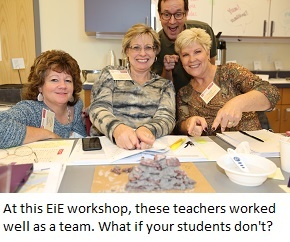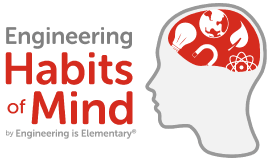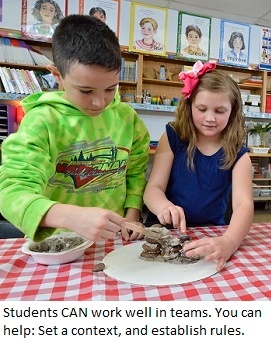Every Thursday on the EiE Blog, we bring you tips and tricks that help you teach your best.
 During every Engineering is Elementary (EiE) professional development workshop, we ask teachers to wear their “Student Hats” while they work through the hands-on engineering activities, just the way their students will. Afterwards, they put on their “Teacher Hats” to reflect on the experience. Recently, during the “Teacher Hat” debrief, one teacher raised her hand, looking concerned. “Do my students HAVE to work in teams?” she asked. “I think there’ll be too many behavior issues. It will detract from the content of the lessons.”
During every Engineering is Elementary (EiE) professional development workshop, we ask teachers to wear their “Student Hats” while they work through the hands-on engineering activities, just the way their students will. Afterwards, they put on their “Teacher Hats” to reflect on the experience. Recently, during the “Teacher Hat” debrief, one teacher raised her hand, looking concerned. “Do my students HAVE to work in teams?” she asked. “I think there’ll be too many behavior issues. It will detract from the content of the lessons.”
Great question. SHOULD you allow your students to work through EiE activities independently?
Why Teamwork Matters
What the teacher said was true: elementary students may have a hard time working collaboratively—especially in the lower grades, or at the beginning of the school year, when they’re still learning your classroom routine. It’s also true that some behavioral issues are challenging to address!
But when you teach engineering, you want students to both 1) acquire subject matter knowledge AND 2) apply real-world science and engineering practices. Collaboration is an extremely important practice, for both engineers and scientists! Most of the greatest breakthroughs in history have been work of collaborative teams, not solitary geniuses.
Even if your students don’t grow up to be scientists or engineers, collaboration is still a  critical 21st century skill. When you coach your students to work collaboratively, you’re helping them develop what we call “engineering habits of mind”—ways of thinking and approaching learning that will stand them in good stead throughout their school and work careers.
critical 21st century skill. When you coach your students to work collaboratively, you’re helping them develop what we call “engineering habits of mind”—ways of thinking and approaching learning that will stand them in good stead throughout their school and work careers.
Read more about Engineering Habits of Mind.
Four Fast Tips for Fostering Teamwork
Here are some tips for fostering collaboration and avoiding or redirecting behavior problems:
 SET A CONTEXT: Be explicit with your students about why collaboration is important. (Watch this video for an example of what to say.)
SET A CONTEXT: Be explicit with your students about why collaboration is important. (Watch this video for an example of what to say.) - GET STUDENT BUY-IN: Take time at the start of the school year to establish what collaboration looks like. Pick a fun activity that requires teamwork. Invite students to identify and agree on rules of group behavior, like “Take turns talking,” “Be polite and respectful,” or “Listen to others.” Write these rules out and post them in the classroom.
- FORM DIVERSE GROUPS: Homogeneous groups may work more smoothly at first, but diverse groups will be more creative, and the students will learn from one another.
- ASSIGN ROLES: Make sure each student in the group has a distinct assignment, like scribe (records data), materials coordinator (picks up and distributes materials), facilitator (keeps group discussions on track); presenter (shares the group’s findings with the class).
Try these strategies in your own classroom. You’ll find that you spend less time addressing behavior issues and more time helping your students engage in hands-on learning.
Do you have a tip for effective teaching with EiE? Share it!
Engineering is Elementary is a project of the National Center for Technological Literacy® at the Museum of Science, Boston.









